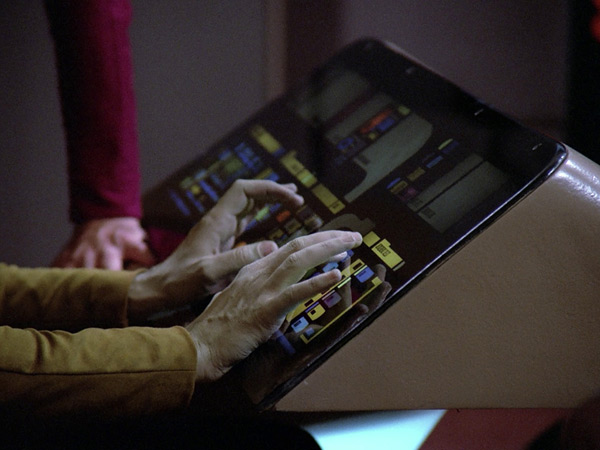Gestural Computing in Finance
MOD/L has always been fascinated by alternate input controllers, and especially hacking them beyond their original intent. Certain expressive mediums, like sound design and performance art, lend themselves well toward these types of controls, and many years of research, experimentation and application has been done on this space. From Leon Theremin’s experiments in the 1920s, to Nam June Paik and Charlotte Moorman’s Video Cello in the 1960s, these fields of expressive art helped to set the stage of our current trends with low-cost gestural computing.
Science Fiction has also helped to lead our thoughts on interface, in particular, multi-touch interfaces. Consider Star Trek’s Enterprise interface, and any modern tablet, for example:

In the last two decades, what I’ll call the ‘futurist fascination’ with gestural or physical interfaces has manifested in Minority Report, and later, Iron Man, as forms of technology interaction: virtual or physical walls of interface, highly advanced A.I., and a magical ‘waving of the hands’ to interact with the system.
Minority Report
Iron Man
These high concept systems help to inform many of the current innovations in the gestural space — gaming systems like Wii or Kinect (and the hacker cultures that have formed around those systems); the Leap Motion — arguably the most successful Kickstarter project to date; the forthcoming Myo armband, which could take advantage of natural human nervous system latency, and more.
When considering any of these types of devices in a gaming, music, performance art, or even medical context, the applications are endless and exciting – drive the car with a virtual steering wheel, or dry run a particular surgical procedure in advance. Replication of existing physical interactions in each of those contexts just makes sense.
However, when considering business or particularly finance oriented applications, a more nuanced approach must be taken – there aren’t many physical interactions to necessarily model. We’ve spent some time looking at this particular space, however, and have found a number of creative approaches to gestural computing for finance.
MOD/L worked closely with our development and design teams, to build a simple example of combining Leap Motion and the LeapJS controller API, with HTML5 interactions, to both operate pinch and zoom on a stock chart, and rotating a 3d cube of portfolio performance:
Here’s another experiment approximating an Iron Man style interface with a Leap:
One of the benefits of gestural computing, however, is to be able to work at a different scale than a personal computer. For example, what happens when you build a massive wall of touch interface, as MultiTaction has? We have added a number of F2 Apps to this interface, seen below.
Or, activate an entire conference room with sensors, gestural awareness, and high-bandwith collaboration tools, a la Oblong Industries?
And last, on the fun-but-not-terribly-useful side of things, what would happen if you added traditional CME trading hand signals to a Leap Motion? Cameron, at least, would have a lot of fun.
